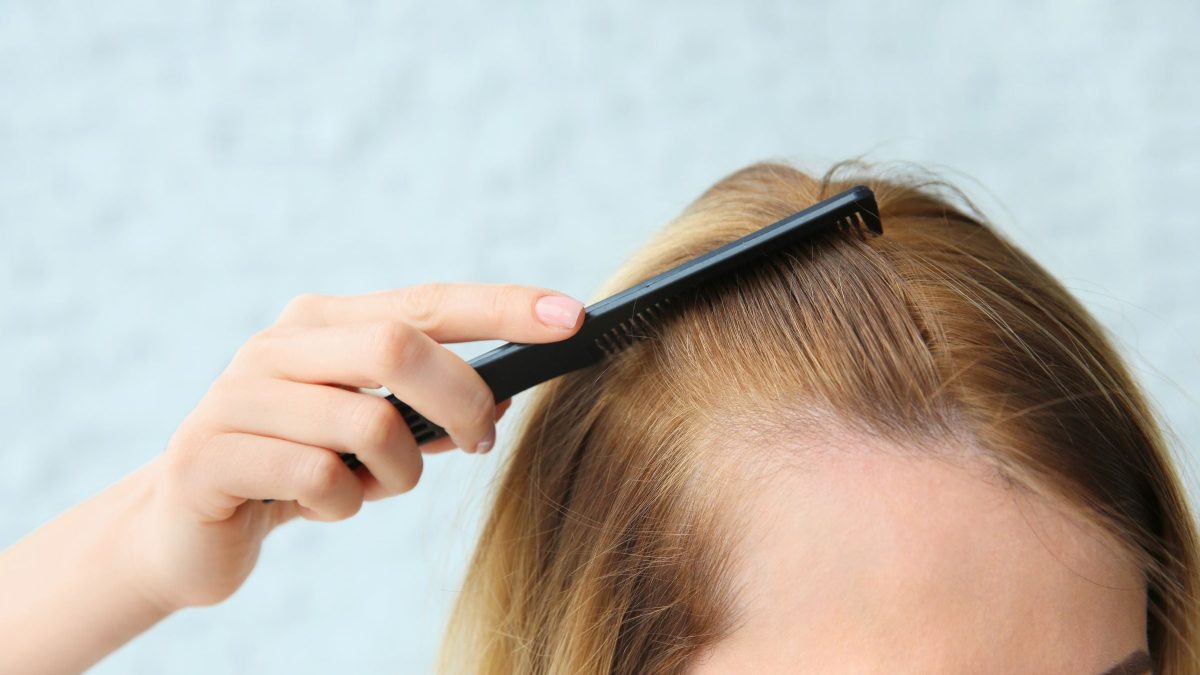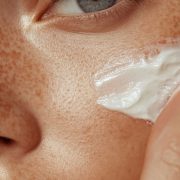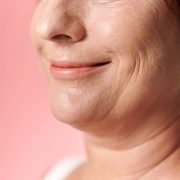Nature’s Answer to Hair Thinning: Exploring the Power of Rosemary Oil
Posted on September 19, 2024 Written by: 100% PURE®

Few beauty conundrums can throw a woman into a frenzy faster than hair loss. Losing a few strands daily is completely normal. But when you’re shower drain clogs and resembles the Lock Ness Monster, losing your strands can be hair-rowing! Luckily, the solution to your hair loss could be just feet away from your shower and into your kitchen. Cue a culinary delight and hair excite rosemary!
With growing concerns about harsh chemicals in conventional hair loss treatments, rosemary has become a go-to choice for many seeking a natural and effective solution for not only hair loss but as a promising regrowth alternative to chemical-laden minoxidil.
Follow along as we comb through the causes of hair loss and compare rosemary to minoxidil for hair loss solutions – plus explore the power of rosemary oil for improving hair strength, scalp health, and regrowth. It’s time to reclaim those drains with natural hair loss treatments!
Understanding Hair Loss
When you’re not sprouting strands or worse, clumps of hair are clogging your drain – things can get quite hairy! Few beauty concerns can throw a woman into a tizzy faster than hair loss. And hair thinning isn’t just a problem for ladies. The bald pattern in men can shake their confidence and leave them self-conscious.
There are about as many triggers of hair loss as there are lotions and potions to treat it. While some treatments help with hair fallout, most others are the equivalent of snake oil. But before you can truly discover your ‘mane’ friend from fraudulent foes of hair regrowth treatments, you need to understand the root causes of hair thinning and loss.
#1. Scalp Health
Just as you won’t have lovely flowers from a bed of bad soil, you won’t have healthy, luscious hair from an unhealthy scalp. Speaking of roots, healthy hair starts with a healthy scalp. Follicles that are chock-full of oil or blocked by dead skin spell trouble and will affect the quality of hair growth. It’s important to wash our scalps to remove the build-up of dead skin and help keep the hair follicles pathway clean and healthy.
#2. Pregnancy
Oh, mamma mia! The beauty of becoming a mom meets a less ideal facet of pregnancy: hair loss. While concerning, hair thinning or loss can be caused by natural hormonal changes necessary for supporting your growing baby. It can also be due to stress on the body, or medical conditions that accompany pregnancy. But don’t worry, beautiful moms-to-be – pregnancy and postpartum hair loss is completely normal, and only a temporary phase.
#3. Hair Damage
When it comes to the health and integrity of our hair, the adage “less is more” couldn’t be more fitting for saving your strands. Going overboard with chemical treatments and processes, such as hair coloring and straightening, and excessive heat styling can weaken the bonds of the hair, making it dull and prone to breakage and loss. Give your hair a good break and choose wisely to not chemically overload or over-treat your tresses.
#4. Anemia
Good old Fe, aka iron, is one of our best friends on the periodic table. Without proper iron levels, your body can’t produce enough hemoglobin for red blood cells to carry oxygen around the body. These red blood cells are essential for bodily functions, like hair growth. A lack of oxygen supply to hair can lead to hair loss, as well as dry, lackluster skin – and a lack of energy!
#5. Hormonal Imbalance
Besides potential hair loss from hormonal shifts during pregnancy, there are other hormonal hair culprits. Changing or starting birth control as well as monthly cycles can impact your mane. Various hormonal shifts with, for instance, testosterone can cause hair loss and male pattern baldness. While we can’t always change what’s causing it, we can strengthen it with natural hair regrowth remedies.
#6: Seborrheic Dermatitis
Healthy scalps are the fertile bed of soil from which luscious hair grows. An itch here, a flake there – normal scalp behavior! However excessive itchiness and fallout may be attributed to something going on with your sweet, sensitive scalp. One of the most common causes is seborrheic dermatitis: an inflammatory skin condition that causes patches of red, flaky, waxy skin. A few common causes are stress or allergic reactions, so that might help you address the root cause of your seborrheic dermatitis.
#7: Thyroid or Autoimmune Disorders
An autoimmune condition can make the body see its hair follicles as foreign, sending it into attack mode – and causing more unwanted fallout. Alopecia areata is one such disorder in which the immune system mistakes hair follicles as unwanted guests. Conditions that primarily affect another part of the body – like thyroid disease and lupus – also mark hair loss as one of many symptoms.
Now that we’ve ‘dug’ into the root causes of hair thinning and loss, it’s essential to have a good understanding of the hair growth cycle. Hair grows in a process that consists of three main phases: anagen, catagen, and telogen. Here’s a breakdown of each phase:
Anagen Phase
During this active growth phase, hair follicles produce new cells, resulting in the continuous growth of your hair. The duration of the anagen phase varies per individual, but it generally lasts between two to seven years. The longer the anagen phase, the longer your hair can grow.
Catagen Phase
After the anagen phase, the hair follicles transition into the catagen phase, which is a short transitional phase. During this phase, the hair follicles shrink and detach from the blood supply. This phase typically lasts for about two to three weeks.
Telogen Phase
The telogen phase, also known as the resting phase, is when the hair follicles are inactive. The old hair remains in the follicles while new hair starts to grow beneath it. This phase lasts for approximately two to four months before the old hair falls out, allowing new hair to take its place.
Hair color treatments, such as dyeing, bleaching, or using chemical relaxers, can significantly impact the health and growth of your hair. Other factors that affect hair health and growth include:
Damage to Hair Structure
Chemical treatments can weaken the hair structure, making it more prone to breakage and damage. The harsh chemicals in hair dyes, relaxers, and hair heat protectants can strip away the natural oils that keep your hair moisturized and protected. Over time, this can lead to dryness, brittleness, and split ends.
Scalp Irritation
Some hair color products contain ingredients that can irritate the scalp, causing redness, itching, and discomfort. Continuous exposure to these chemicals may lead to scalp inflammation or dermatitis, which can hinder the hair growth process.
Transition Challenges
If you’ve been regularly coloring your hair and decide to grow out your natural color, the transition process can pose its own set of challenges. As your hair grows, the color-treated portions will have a noticeable contrast with your natural roots, which can be aesthetically displeasing for some.

Minoxidil: The Traditional Approach
By now most of us are familiar with minoxidil, a.k.a. Rogaine, or have known about its existence for decades from the amount of men who flocked to their doctor in the 80s for the crazed hair growth treatment. Its discovery was rather accidental as minoxidil was originally developed in the early 1960s as an oral treatment for high blood pressure. In the early trials for the treatment of blood pressure, the curious side effect of hair growth was documented. After about two decades of research, the FDA approved topical minoxidil to treat male hair loss (and thus, Rogaine was born).
After minoxidil was made available to women via prescription in the ’90s, and then a few years later granted FDA approval to obtain the hair treatment over-the-counter, minoxidil has been a household name and gold standard for hair thinning and loss.
Interestingly, scientists can’t quite pinpoint the exact reason minoxidil works to help with hair regrowth. Perhaps since it belongs to a group of drugs known as vasodilators, minoxidil creates increased blood flow to the hair by dilating or widening the blood vessels in the scalp. This, in turn, increases blood flow to your hair follicles, which helps to promote hair growth.
Other data suggests that minoxidil increases a specific enzyme in the hair follicle, extending its growth or anagen phase. According to Rogaine, their proprietary solution [minoxidil] “restores inactive hair follicles” and “increases protein production.” Moreover, it “revives and increases the size of hair follicles and extends your hair’s natural growth cycle so you can regrow thicker, fuller hair.” No matter how minoxidil works, it’s clear countless people across the globe have tried it to regrow their hair and for its additional benefits for hair concerns.
Stimulates hair growth: Minoxidil is a topical, FDA-approved medication to treat hair loss in men and women by stimulating your hair follicles to grow thicker, fuller hair.
Increases hair thickness and density: In addition to stimulating hair growth and quelling a receding hairline, minoxidil can increase the size and thickness of each strand. In other words, hair grows back fuller, thicker, and healthier.
Extends hair growth phase: Minoxidil extends the growth phase of the hair growth cycle in hair follicles.
Treats hair disorders: Minoxidil is shown to be effective in promoting hair regrowth and density in patients with Androgenetic alopecia and female pattern hair loss.1
So, does minoxidil fall under the too-good-to-be-true category? There are plenty of hair growth gimmicks out there, but minoxidil is not one of them. Minoxidil is one of the most dermatologist-recommended treatments for stimulating hair growth and plenty of patients who use it correctly see a difference.
However, with many potent hair care treatments, they can carry side effects. Some limitations and side effects of minoxidil include:
Pregnancy risks: If you’re pregnant or trying to become pregnant, you should not use minoxidil. Otherwise, minoxidil should be safe for you to use—but you should only use minoxidil under the close guidance of a dermatologist.
Scalp side effects: You may experience redness, itching, or flakiness when using minoxidil because it increases blood flow to the scalp.
Additional hair growth: In addition to an increase in hair growth, females may experience facial hair growth as an unwanted side effect at higher potencies known as , which appears as fine hair growing on areas like the face and hands.
As we’ve been seeing a surge in consumers being more conscious about the products they’re putting on their skin, it’s created a shift in people seeking minoxidil alternatives. While some individuals shy away from the potential adverse side effects of minoxidil, others want to nix the harsh chemicals and opt for natural hair loss treatments.
At the focus of herbal hair care, rosemary oil has been cherished throughout history by ancient civilizations, leaving an indelible mark on beauty rituals. This for its potential to stimulate hair growth, improve scalp health, and more innumerable benefits for hair!
Rosemary: Nature’s Hair Growth Elixir
Rosemary, known by the Latin name Rosmarinus officinalis, or “dew of the sea,” has been cherished throughout history by ancient civilizations, leaving an indelible mark on beauty rituals and folklore. Many contend that rosemary was given this name because it required very little water to survive and could literally sustain itself and even thrive on moist on-shore breezes, thanks to its aromatic, needle-like leaves.
The Egyptians regarded rosemary as a symbol of transformation and used it in their beauty regimens to invigorate the skin and hair. Meanwhile, the Romans, recognizing its versatile qualities, employed rosemary in fragrant baths and perfumes, valuing it for its cleansing and purifying properties.
In Greek culture, rosemary held a sacred status, believed to enhance memory and concentration. It was woven into wreaths worn by scholars and poets as a symbol of intellect. The folklore surrounding rosemary often depicted it as a potent protector against evil spirits, making it a staple in weddings and ceremonies.
In addition to rosemary’s centuries of usage, the pale goldish oil has actually become the golden ticket for strand stress and success, as it’s been found to hold a number of different benefits for hair. This is due to the active compounds and the multifaceted properties of rosemary that promote hair growth. The oil contains compounds like rosmarinic acid, carnosic acid, and ursolic acid, which possess antioxidant, anti-inflammatory, and antimicrobial properties. These properties work synergistically to benefit hair health.
Rosemary oil’s effectiveness for hair can be attributed to its scientifically backed properties. A study published in the compared the effects of rosemary oil and minoxidil. The study found that rosemary oil was just as effective as minoxidil in promoting hair growth over six months. This provides promising evidence for rosemary oil’s efficacy in treating hair loss.
While rosemary oil has shown promising benefits for hair, it’s important to acknowledge its limitations. Firstly, individual responses may vary, and what works for one person may not have the same effect on another. Moreover, the effectiveness of rosemary oil in treating hair conditions like hair loss or graying is still an area of ongoing research. Additionally, the quality and purity of the rosemary oil used can greatly impact its efficacy. Diluted or lower-quality oils may not yield the same results as pure, high-quality rosemary oil.
Speaking of the quality of rosemary oil, it’s important to be aware of the different forms of rosemary for hair care, such as essential oil, extract, and infusion that can be created from the leaves, flowers, and stems – or the entire plant.
Rosemary essential oil: This highly concentrated oil is extracted from the leaves and flowers of the rosemary plant. It is often used in aromatherapy and skincare formulations for its invigorating scent.
Rosemary CO2 extract – This form is similar to the essential oil but uses CO2 to extract the rosemary compounds. This usually results in a dark brown, highly viscous ingredient. It’s oil soluble, usually diluted in a carrier oil like sunflower, and can contain residual traces of ethanol.
Rosemary-infused oil – this is produced by macerating dried, chopped rosemary plants into a suitable carrier oil such as sunflower, grapeseed, or sweet almond oil.
Comparing Rosemary and Minoxidil
When it comes to promoting hair growth, many people find themselves at the crossroads of choosing between conventional treatments like minoxidil and natural hair loss alternatives like rosemary oil. Let’s do a comparison of minoxidil and rosemary oil broken down by the following key areas:
Effectiveness in promoting hair growth:
Minoxidil: Clinically proven for hair growth
Rosemary oil: Effectiveness varies, and is less extensively studied
Safety profiles and potential side effects:
Minoxidil: Scalp irritation, dryness, itching, unwanted facial hair growth
Rosemary oil: Minimal reported side effects, potential skin irritation, or allergies
Ease of use and application methods:
Minoxidil: Encouraged to use twice daily and allow it to completely dry for 2 to 4 hours after applying it, including before going to bed. Can stain clothing, hats, or bed linen if your hair or scalp is not fully dry after using the treatment.
Rosemary oil: Can be used a few times a week or more and doesn’t require a specified drying time. Less likely to stain bedding, especially when diluted with a carrier oil.
Cost comparison over time:
Minoxidil: Less cost-effective
Rosemary oil: More cost-effective
Natural vs. synthetic approach:
Minoxidil: Chemical treatment, potential side effects from synthetic ingredients
Rosemary oil: Natural remedy, gentle on the scalp, environmentally friendly, fewer synthetic ingredients
How to Use Rosemary for Hair Growth
There are many ways in which you can use rosemary to increase your hair growth. You must use rosemary oil at least two to three times a week for great results. You can even apply it more times if your routine allows you to. Check out some ways you can incorporate rosemary oil into your daily hair care routine for fuller, more luscious strands.
Rosemary oil scalp massage technique
Mix four to five drops of rosemary oil with other essential oils, whether it’s argan, coconut, or jojoba, and massage it evenly on your scalp. You can keep the oil in your hair for a few hours and then rinse it thoroughly. Keep in mind to not let the oil sit on your scalp for more than a night.
Incorporating rosemary oil into your hair care routine
If you’re looking for a surefire way to use your rosemary oil every day, try adding some to a product you often use. This method can be done with any product that touches your scalp, whether it’s shampoo, conditioner, or a scalp serum. Start small by adding just a few drops of oil to your product, and then proceed to use it as usual.
DIY rosemary-infused hair formulas
If you ever feel creative enough to make a homemade shampoo or soap, keep rosemary as a key ingredient. It will provide many beauty benefits and an amazing fragrance. The much easier option would be to buy hair products that are already made from clean and natural products without an iota of toxic chemicals.
Add a rosemary growth serum.
As mentioned earlier, it’s better to use products that have the right concentration of rosemary oil added to them. 100% PURE’s will increase cell turnover and stimulate hair growth. In addition to the essential oil, it also has vitamin E, sunflower seed oil, castor seed oil, and medicinal herb rosemary. You can apply it 15 minutes before the shampoo and then wash it thoroughly. For best results, use it about 5 to 7 times a week.

Lifestyle Factors Supporting Hair Growth
Achieving healthy and vibrant natural hair growth is a goal for many individuals. To promote optimal hair growth, there are several helpful lifestyle factors, tips, and tricks to consider.
Nutrition for healthy hair: A nutritious diet is crucial in promoting natural hair growth. Include foods rich in vitamins, minerals, and proteins, such as leafy greens, fruits, lean meats, and nuts. Be sure to stay hydrated and add hair-boosting supplements like biotin or omega-3 fatty acids. Try consuming food that is loaded with vitamins and fatty acids like fish, fruits, vegetables, and dry fruits.
Scalp massage: Regular scalp massages stimulate blood circulation, promoting hair growth. Use your fingertips to gently massage your scalp in circular motions for a few minutes each day. This technique helps nourish the hair follicles, reduce scalp tension, and enhance nutrient delivery to the hair roots.
Importance of proper hair care practices: Excessive heat from styling tools like flat irons and curling irons can cause damage to the hair shaft and weaken hair strands. Minimize heat styling or opt for heat-free styling techniques like air drying, braiding, or twist-outs to protect the hair and encourage natural growth.
Importance of proper hair care products: Commercial hair products often contain harsh chemicals that can strip the hair of its natural oils and cause damage. Switch to natural and organic hair products that are free from sulfates, parabens, and synthetic fragrances. Look for gentle cleansers, moisturizing conditioners, and nourishing hair oils to maintain a healthy scalp and promote natural hair growth.
100% PURE Products for Natural Hair Care
If you’re eager to incorporate rosemary into your hair care routine, we’ve got you covered! With different potential triggers and markets flooded with supplements and remedies for hair loss, it can get a bit hairy trying to find safe, effective products. We’re here to help take some of the guesswork out of hair loss treatments, so you can avoid any fallout from shelf stress and your tresses.
Refresh and rebalance your hair with our natural shampoo that features nettle for scalp health and hair growth. Our unique blend of burdock, neem, and nettle works to purify the scalp by unclogging pores while stimulating healthy circulation. Say goodbye to dryness, itching, flaking – all those uncomfortable symptoms that ensue from having a sensitive or oily scalp; this sulfate-free formula is gentle enough for color-treated strands as it deeply moisturizes using ingredients like rose hydrosol and aloe. Plus, vitamin E & pro-vitamin B5 help strengthen locks leaving them softer than before!
Revitalize your hair with this nourishing sulfate-free shampoo for scalp health and hair volume! Layer on the luster and eliminate shedding while stimulating new growth. Keeping color-treated strands safe, hydrated, and strong is easy when you use this deep cleansing formula that clarifies without dehydrating – giving you a freshly boosted look in no time.
This lightweight serum leaves hair feeling softer, smoother, and more manageable without weighing it down. Pro-Vitamin B5 oil for hair creates more shine and fewer split ends. This hair serum nourishes hair and promotes strength.
Our lightweight, non-greasy formula is naturally rich in vitamin E, phenols, carotenes, squalene, and essential fatty acids to deeply moisturize, nourish, and soften strands. It smooths and lightly glosses hair for healthier texture and bounce, as well as extra shine and hair protection, while also acting as an effective detangler, without the slippery, harsh silicones found in most traditional hair serums.
We love serums for how they make our hair look and feel, but we admit we’re a little biased about our very own hair growth serum that’s blended with rosemary for added scalp benefits. Rosemary also does the work of stimulating and conditioning to support the hair without the hard work or hassle.
Conclusion
Sustainability and ethical sourcing of rosemary oil are pivotal in preserving our planet and ensuring fair practices. Opting for ethically sourced and organic oils reflects a commitment to environmental stewardship and social responsibility. By choosing such oils, consumers promote sustainable farming methods that minimize chemical usage, reduce soil degradation, and protect biodiversity. This not only safeguards ecosystems but also ensures the well-being of local communities.
Ultimately, the environmental impact of these choices extends far beyond personal use, contributing to a greener, fairer future where the cultivation of rosemary oil aligns with ethical and sustainable.




